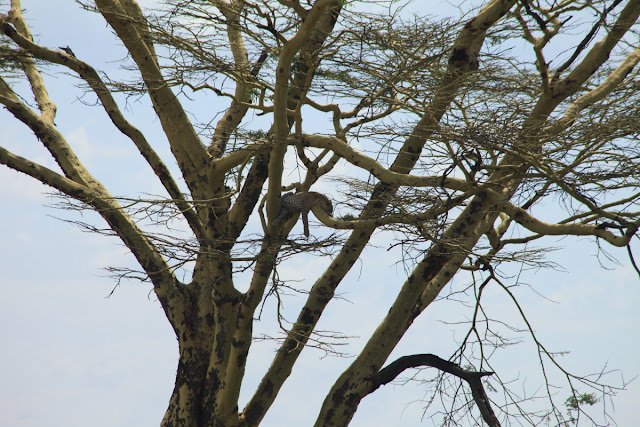We begin at the Kilimanjaro Airport with a one-hour charter flight to the park
Our group traveled together to get shots like this
We soon crossed a portion of the East Africa Rift, a place where the earth's crust is being pulled apart such that huge blocks of land are subsiding downward relative to the rift shoulder. This is a view to the south with the high-standing rift shoulder to the right (and covered in vegetation) and the rift valley to the left covered in brown grass).
Looking out the other window to the north gave us a view of the Ol Doinyo Lengai volcano, an active and rather unique volcano that often erupts carbonate lavas. You can read more about it here. This volcano is rising up to the surface along the East African Rift Faults.
Another volcano crater located along the rift zone
We finally arrived at the dirt airstrip and began our safari
It wasn't long before we saw a black faced vervet monkey
My 300 mm lens was able to capture a nice facial expression. More information about these monkeys can be seen here.
We soon came to a Hippopotamus pool where there were about 35 individuals
These grazers stay in the water during the day time but then come out at night to graze on land
They can be quite dangerous but otherwise look very interesting
Nearby, a solitary water buffalo lounges in a the river
Profile of an acacia tree
An old bull elephant came close to our vehicle but then backed off
We were on safari for only one and a half hours and saw all of these animals before sunset. This photo was taken from the deck of my hotel room.
The next morning we saw another water buffalo

Africa is a land of many colorful birds. This is the lilac breasted roller.
We drove far to the south where the short grass prairie is located. This is animal called a tope.
The long drive was taken to see the migration of wildebeast and zebra north to the Massai Mara. Look at how many animals are in the background - all moving northwest this time of year.
It is estimated that 200,000 animals are on the move right now. Naabi Hill in the background.
After lunch two of my tripmates and myself walked to the top of Naabi hill
Here is a female lion we saw sleeping by the side of the road
She had a collar on for scientific tracking. The male was nearby and we saw them mate. Mating in lions goes on for one week.
On the move
Giraffes were plentiful on this trip to the Serengeti
They move gracefully and with their long necks they are perhaps reminiscent of large reptilian herbivores from the Jurassic time period
We found a sleeping leopard high in an acacia tree. These are the most difficult of the big cats to spot since they are solitary in nature.
The baboons were everywhere and so fun to watch. They can be vicious though when threatened.
We saw many infants riding on the backs of their mothers
I took over 400 pictures and this is just a taste of what we saw. A safari is such a great undertaking.





























I returned at the end of July from a Serengeti safari, in northern Tanzania. I was amazed by the little pockets of water scattered here and there. I didn't understand how the topsoil could be so dry and yet there were numerous streams flowing between the patches of plains. Where does the water come from? Is it ground water flowing from the escarpment in Kenya?
ReplyDeleteUnknown - I think it must be groundwater as this area is at the head of the Nile drainage. Could have been recent rains too! Thanks for commenting. Wish I knew your name.
ReplyDelete